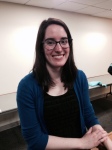by Gae Polisner
 Editorial Assistant Kelsey Murphy of Balzer & Bray led a wonderful workshop at the SCBWILI on Saturday April 13, at the Huntington Public Library on Long Island. The workshop was on “Crafting a Dynamic Character.”
Editorial Assistant Kelsey Murphy of Balzer & Bray led a wonderful workshop at the SCBWILI on Saturday April 13, at the Huntington Public Library on Long Island. The workshop was on “Crafting a Dynamic Character.”
Ms. Murphy provided a four-pronged outline on how to craft dynamic characters, explaining that, to draw in readers – and prospective agents and editors! – realistic characters (1) must have a want, (2) must change, (3) must be emotional and reactive, and (4) must be specific (not stereotypical or clichéd).
Using examples from both participants’ own two-minute writing exercises prepared on the spot, as well as from well-loved picture books and works of young adult and middle grade fiction, Ms. Murphy walked the audience through each prong of character building, helping us to see how it is done, and why each prong matters.
“A character will change, while still being that character at the core.”
Always coming back to prong one, that a character must have wants in order for the reader to connect—and to build plot—at the outset of a story, Ms. Murphy explained that a writer should even know the wants of her secondary characters: “A character that wants for nothing is dull.” She explained physical wants versus emotional wants, active and overarching wants to build characters from the ground up—and to view their personal history through these statements of want.
Elaborating that showing, not telling, the history leading to those wants is key to a well-told story, Ms. Murphy stated: “A character with a want has power and will encounter conflict either in pursuit or in lack of pursuit of the desire itself . . . and the backgrounds to those wants give the book momentum and energize the story.”
Carrying these precepts over to picture book writing, Ms. Murphy shared that simplicity of focus in picture books matters. At the core of a picture book, there should be one central idea “blown out” via repetition or exploration or upending of classic tropes—bringing them to a funny or unusual setting, while the simple want of the story remains clear. “She wants a frog!” Ms. Murphy exclaimed, alluding to one of her favorite picture books her house has recently acquired.
Following the workshop, Ms. Murphy generously fielded an audience Q&A session and took writers’ individual questions.
—————–
Gae Polisner is the award-winning author of THE SUMMER OF LETTING GO and THE PULL OF GRAVITY (fsg/Frances Foster Books). She lives on Long Island with her husband, two sons, and a suspiciously-fictional looking dog she swore she’d never own. When she’s not writing, she can be found in her wetsuit in the open waters off the Long Island Sound.

